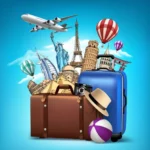Dreaming of exotic cuisines, passport stamps, and stunning landmarks? International travel opens up a world full of unforgettable experiences, cultural learning, and thrilling adventures.
Whether you’re planning your very first overseas trip or you’re a seasoned globetrotter seeking fresh destinations, this guide has you covered.
From top international hotspots and smart booking tips to transportation, accommodations, must-try cuisines, and hidden gems—discover it all. Travel with Savali Holidays, the best travel agency, and make your journey smooth, memorable, and truly extraordinary.
Explore everything, including must-try foods, lodging, transportation, hidden treasures, and the best places to go in the world. Make your trip easy, unforgettable, and genuinely remarkable by booking with Savali Holidays, the top travel company.
1. Why Travel Overseas?
Beyond simply marking destinations off a bucket list, traveling overseas is about seeing other cultures, expanding your horizons, and growing as a person. You get to experience a range of customs, languages, landscapes, and cuisines while creating lifelong memories.
The main benefits include exposure to culture and personal growth.
Developing relationships and friendships
Wonders of Nature and History
Cooking Adventures
2. Popular International Destinations (2025 Picks)
Europe
Italy: Cities like Rome, Florence, and Venice are famous for their architecture, art, and gastronomy.
France: Although Paris is a must-see, you should also go to Provence for its lavender fields and Bordeaux for its wine.
Switzerland provides stunning train excursions and the splendor of the Alps for people who love the great outdoors and snow.
Asia Japan: Osaka, Kyoto, and Tokyo blend modern innovation with ancient history.
Thailand: From Bangkok’s vibrant nightlife to Phuket’s beaches and Chiang Mai’s mountain temples.
Vietnam: Hoi An, Ha Long Bay, and a vibrant street food culture.
United Arab Emirates, Middle East: Modern marvels amid the desert, Abu Dhabi and Dubai.
Jordan: Visits to the Dead Sea, Petra, and Wadi Rum in the desert.
North America, USA: From the New York skyline to the California coast and the Grand Canyon in Arizona.
Canada: Banff and Jasper National Parks, Niagara Falls, Toronto, and other multicultural cities.
Sydney, Melbourne, and the Great Barrier Reef are all part of Oceania, Australia.
New Zealand: Queenstown for adventure and Rotorua for Maori culture.
Africa
South Africa: Cape Town, the Garden Route, and a safari in the Kruger National Park.
Morocco: Travel to coastal cities like Essaouira, the Sahara desert, and Marrakech’s souks.
3. A Comprehensive Guide to Booking International Travel:
1. Create a Budget Compute travel expenses, accommodation, food, insurance, visas, transportation, and activities.
2. Decide Where You Are Consider: Weather patterns, seasons, local culture, and security
Entry requirements
3. Book Flights
Make use of fare comparison services like Skyscanner Flights on Google and Kayak.
Make your reservation two to four months in advance to get the greatest deals.
4. Get your travel paperwork ready: A passport with a minimum six-month validity period
Visas (either an e-visa or a sticker, depending on the country)
Travel insurance
5. Booking options for lodging consist of:
Booking.com (hotels, flats)
Airbnb (unusual stays, homestays)
Hostelworld (inexpensive lodging)
For Asia, Agoda is great.
6. Make a travel schedule
Utilize programs like Google Maps, Rome2Rio, and Sygic Travel. Create a daily plan that takes into consideration:
Highlights of Interest
Travel time Local festivities and celebrations
7. Travel Insurance
When traveling overseas, always purchase health, cancellation, and lost luggage insurance.
Transportation: Air travel is the most common way to see the world.
Taking an international flight is the fastest way to reach your destination.
Utilize layovers to see two cities for the price of one.
By Sea Cruises: Ideal for trips to Alaska, the Mediterranean, or the Caribbean.
Ferries: Helpful in Europe and Southeast Asia.
By Land Trains: EuroRail (Europe), JR Rail Pass (Japan), Amtrak (USA), and Indian Railways.
Buses: Flixbus in Europe, Greyhound in the USA, and local equivalents in Asia.
Road Trips: Rent a car in countries like Australia, New Zealand, Canada, and the United States.
8. Accommodations: Where Do I Stay?
Types of Accommodation
The best kind for the average cost (USD/night)
Inns for solo travelers and backpackers $10 to $40
Low-cost lodging for culture and travel Hotels from $15 to $60 $50 to $300 or more for all kinds of travelers
Resorts Luxurious family vacations $150 to over $500
Airbnb Long trips and local stays $30 to over $200 Boutique hotels for couples and luxury visitors Between $100 and $400: Consult TripAdvisor or Google reviews.
Look for locations near public transportation.
Review the cancellation policy at all times.
9. Must-Try International Cuisine
Trying out other cuisines is one of the best parts of any trip abroad. The following international dishes are a must-try:
Remarks on the National Cuisine to Sample
Italy’s carbonara pasta is best enjoyed in Rome.
Japan Sushi and ramen Try some sushi at Tsukiji Market.
India Mumbai or Delhi street food: dosa with butter chicken
France Croissants and escargot Buy pastries from bakeries in the area.
Night markets are Thailand Soup with Tom Yum and Pad Thai Food’s nirvana.
Al Pastor Tacos from Mexico Eat at food stalls along the way.
Turkey Baklava and Kebab Istanbul’s street food scene
Moroccan tagine-topped couscous Savor a traditional riad dinner.
Ceviche from Peru Lima is the gastronomic capital of Vietnam. Pho Banh Mi The street food in Hanoi is very good.
10. Undiscovered Gems You Have to See
Outside of well-known tourist locations, there may be hidden treasures that offer authentic experiences:
Europe Albania: The Riviera beaches and Ottoman towns like Berat.
Slovenia: Lake Bled and Triglav National Park.
Asia Bhutan: Eco-friendly travel and a pristine environment.
Sri Lanka: The lesser-known beaches and historic remains of Anuradhapura.
South America Colombia: Medellín’s comeback and Cartagena’s colonial beauty.
Bolivia: Salar de Uyuni (Salt Flats) and the lively markets of La Paz.
Africa: The unique fauna and baobab woods of Madagascar.
Ethiopia: Lalibela’s rock churches and the ancient Axumite legacy.
Oceania: Tasmania, Australia’s pristine nature and fresh seafood.
Niue Island is a coral atoll with caverns, snorkeling, and amiable locals.
11.Cultural Etiquette & Safety Advice
Cultural Etiquette: Learn About Customs in Your Area: What is deemed acceptable in one country could be considered offensive in another.
Dress modestly when in places of worship.
Discover the Fundamentals of Local Expressions (Hello, Please, Thank You).
Safety Tip: Keep digital and hard copies of any important documents safe.
Don’t flaunt your possessions.
Make use of authorized taxis or ride-sharing apps like Uber, Grab, and Bolt.
Consult the government’s advice before you travel.
Carry a small medical kit with the essentials.
12.The Best Time of Year to Travel Abroad
Justification for Area Top Months
Warm-weather festivals in Europe from May to September
Southeast Asia November to February pleasant weather with the dry season
October to April in the Middle East Avoid the summertime heat.
Africa South America’s safari season runs from June to October. March through May and September Mild temperatures and fewer crowds
The Ocean Islands (summer, December to February) The beach weather 10. Final Thoughts: Pack Your Bags and Go Exploring!
A life-changing event, traveling overseas is full of surprises, adventure, and new cuisines. By planning ahead, making informed bookings, respecting local traditions, and taking risks, you can create a journey that is both entertaining and educational.
Make your trip plans, choose your accommodation, plan your activities, and don’t forget to account for unanticipated events. Enjoy an espresso in a Roman café, go snorkeling in Bali, or dance in the streets of Rio de Janeiro—the world is waiting for you!






